July 29th, 1888 — May 28th, 1959

Above: George Chesebro in Perils of the Royal Mounted (Columbia, 1942).
George Chesebro worked almost exclusively in serials and B-westerns throughout his sound-film career, usually as a henchman of varying degrees of importance. Although Chesebro’s roles ranged in size from the leading “action heavy” to background thugs, his characters were always easily distinguishable, thanks to Chesebro’s swaggering manner and the aggressively cocky way he sneered out his lines. He specialized in playing loudmouthed, impulsive, and nervously talkative villains, and was always one of the most colorful supporting matinee heavies even when relegated to just one or two lines.
George Chesebro was born in Minneapolis, and began his acting career at the age of nineteen, joining a Minnesota stock company. Around 1913, he signed on with an international touring vaudeville group that journeyed as far afield as Hong Kong and Shanghai. He launched his movie career upon his return to America in 1915, and, after a few supporting parts, began working as a leading man in Westerns (The Land Just Over Yonder), historical adventures (The Spirit of 76), and other outdoor-oriented films. He played the hero opposite serial queen Ruth Roland in the silent cliffhanger Hands Up, but his participation in this film was interrupted by service in World War 1. He picked up his career where he left off after the end of the war; he spent the earlier years of the 1920s playing leads in several more serials (The Jungle Princess, The Hope Diamond Mystery) and starring in a series of north-woods Westerns for the independent outfit Morante Productions. The middle years of the decade, however, found Chesebro, now pushing forty and getting rather lined in the face, shifting into villainous roles in the type of films he had previously starred in—low-budget adventure films, B-westerns, and serials.
Chesebro continued his new career as a B-movie badman into the sound era, using his nasal voice to enhance his villainous characterizations. The first half of the 1930s found him working chiefly for small “Poverty Row” studios like Reliable, Trem Carr Pictures, Argosy, and Mascot. The last-named studio cast him in his first sound serial in 1934, a modern-day Western called The Law of the Wild. His part here was small; he played one of hero Bob Custer’s ranch hands, who was suborned by fellow wrangler Richard Alexander into helping steal Custer’s prize horse Rex; Chesebro’s attempts to lasso the spirited steed resulted in his being chased off a fatally high cliff by the horse in the first chapter.
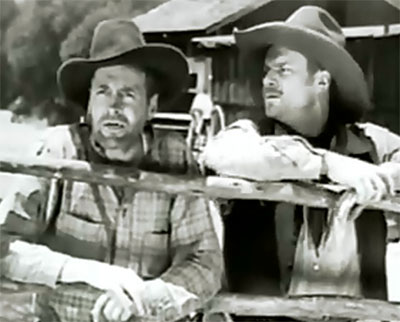
Above: George Chesebro and Richard Alexander in The Law of the Wild (Mascot, 1934).
Mystery Mountain, another modern-day Western cliffhanger, was released by Mascot a few months after Law of the Wild, and gave Chesebro a slightly more substantial part. He played Anderson, one of a gang of outlaws that followed the orders of a mysterious criminal called the Rattler. Bob Kortman and Lew Meehan were the lead henchmen in this serial, and Chesebro was a “pack member” or background henchman, albeit more noticeable than a typical member of this species, because of the enthusiastically aggressive manner in which he delivered his few lines.

Above: Ken Maynard has the drop on Frank Ellis and George Chesebro in the photo on this lobby card for Mystery Mountain (Mascot, 1934).
Chesebro’s next serial assignment was a bit in the first chapter of Queen of the Jungle (Herman Wohl Productions, 1935). As an explorer named Ken Roberts, he only had a few lines in the serial’s prologue sequence before dying in a futile attempt to stop a balloon containing five-year-old Marilyn Spinner from sailing off into the sky (the little girl then grew up to be the titular heroine).
Chesebro returned to Mascot Pictures for two more serials later in 1935—The Miracle Rider and The Adventures of Rex and Rinty. The first cast him as Crossman, the shifty henchman of corrupt businessman Edward Hearn, who muscled in on the land-grabbing schemes of villain Charles Middleton. As the henchman of a secondary villain, Chesebro spent most of his time in the background in Rider, but handled his occasional dialogue with with gusto–particularly when gloating over robbery proceeds (in his first scene) and nervously squealing in order to dodge the hangman’s noose (in his last scene).
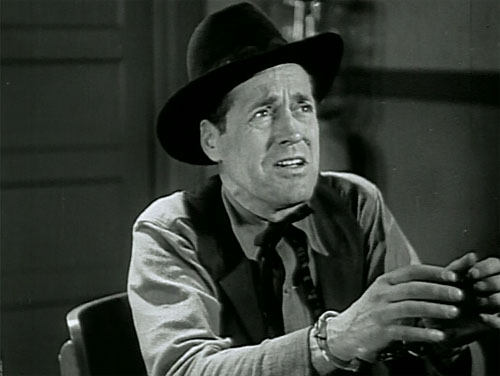
Above: George Chesebro engages in some frantic plea-bargaining in The Miracle Rider (Mascot, 1935).
Adventures of Rex and Rinty pitted Chesebro against his Law of the Wild antagonist Rex the Wonder Horse; this time, Rex was a sacred horse stolen from the island of Sujan, and Chesebro was Anderson, one of a gang of thugs hired to purloin the stallion by polo-playing tycoon Harry Woods. As in Mystery Mountain, Chesebro was distinctive despite having comparatively few lines, and delivered his character’s panicky shouts or gloating sneers with great vigor.
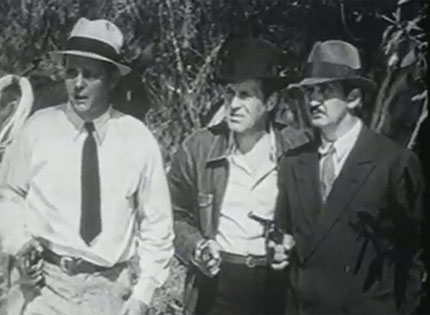
Above, from left to right: Edmund Cobb, George Chesebro, and Charles King have the drop on an off-screen Kane Richmond in The Adventures of Rex and Rinty (Mascot, 1935).
By 1936, independent B-western producers were beginning to fade due to competition from slicker studios like Columbia and the newly-formed Republic. Chesebro survived the demise of studios like Reliable, and carried his badman act over to the Columbia westerns of Charles Starrett (The Cowboy Star, The Mysterious Avenger) and Republic’s new Gene Autry and John Wayne films (Red River Valley, The Lawless Nineties). One of Chesebro’s last “Poverty Row” productions was the serial Custer’s Last Stand (Stage and Screen, 1936), an ambitious but rather sloppily assembled historical chapterplay that nevertheless gave Chesebro an unusually good acting showcase. He played a lieutenant named Frank Roberts, dishonorably discharged for drunkenness, who aided some of the villains’ schemes against the cavalry but who eventually realized the error of his ways (partly through his love for Lona Andre, one of the serial’s leading ladies). Chesebro’s character returned to duty in the climactic chapter, receiving a mortal wound at the Little Big Horn and keeping the Stars and Stripes flying until he died. Melodramatic as it sounds, the scene was also quite stirring; overall, the role allowed Chesebro to display the greatest acting range of his entire sound-era career.

Above: The dying George Chesebro holds the flag high in Custer’s Last Stand (Stage and Screen, 1936).
Chesebro was back in more familiar territory in Robinson Crusoe of Clipper Island (1936), his first Republic serial. As a crook named Draker, he led a gang of Pacific-Islands-based spies and saboteurs on behalf of a mystery villain known as “H. K.” H.K. was an unseen background figure for most of the serial, which made Chesebro the de facto head villain in many sequences. He took full advantage of his extended screen time–sneering confidently when he reported successes to his boss, loudly and smugly telling his subordinates what to do, and displaying an entertainingly sarcastic insolence towards a higher-ranking spy (Lloyd Whitlock) who temporarily visited the island and tried to boss him around.
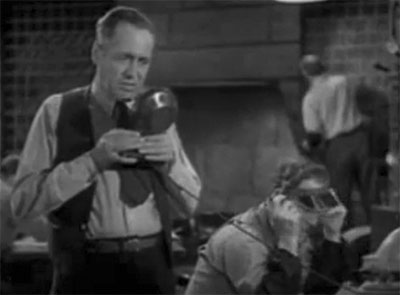
Above: George Chesebro converses with “H. K.” via radio in Robinson Crusoe of Clipper Island (Republic, 1936).
SOS Coast Guard (Republic, 1937), cast Chesebro as the field commander (DeGado by name) of a munitions-smuggling gang. However, he had comparatively little to do here: his boss (Bela Lugosi) was onscreen throughout, while Richard Alexander (as Lugosi’s monstrous mute slave) handled most of the serial’s active villainy. As in his Mascot outings, however, Chesebro jumped on his dialogue with an aggressive flair that kept him from being completely overshadowed.

Above: Roy Barcroft and George Chesebro eavesdrop on hero Ralph Byrd’s intercom in SOS Coast Guard (Republic, 1937).
Chesebro would concentrate chiefly on B-western work—for Republic, Columbia, Warner Brothers, and others—for the rest of the 1930s, but managed a few more serial appearances. Great Adventures of Wild Bill Hickok (Columbia, 1938) featured him briefly as an outlaw named Metaxa who was appointed sheriff by the villains in the absence of hero Bill Elliott (as Hickok); Chesebro left town abruptly when Elliott returned after gunning down the hired killer sent to stop him.
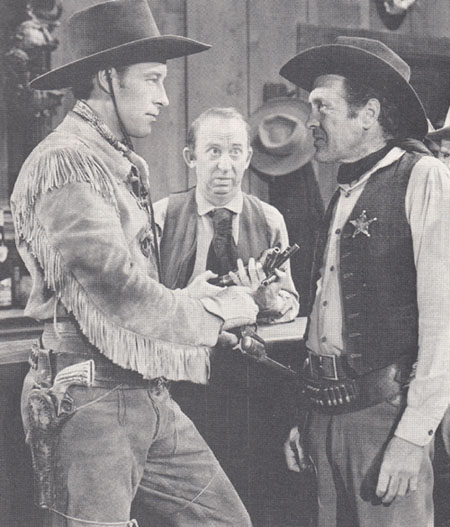
Above: A pop-eyed Roscoe Ates watches a confrontation between Bill Elliott and George Chesebro in The Great Adventures of Wild Bill Hickok (Columbia, 1938).
Flying G-Men (Columbia, 1939) gave Chesebro a one-chapter bit as a thug named Red, while Mandrake the Magician (also Columbia, 1939) gave him a more prominent part as a henchman pack member named Baker, who took command of several of the heavies’ enterprises–like scouting a dam site that was slated to be targeted by his boss’s ray machine (Chesebro’s over-hearty manner as he pumped the dam’s foreman was particularly enjoyable). Daredevils of the Red Circle (Republic, 1939) cast Chesebro as an arrogant detective named Sheffield who refused to believe that the “amateur” heroes would be of any use in chasing down the mad criminal “39-0-13.” Sheffield turned out to be not only arrogant, but crooked as well, and caused several problems for the good guys in the first chapter before the character dropped out of sight.

Above: George Chesebro thinks that he and his colleagues have eluded Mandrake the Magician (Columbia, 1939).
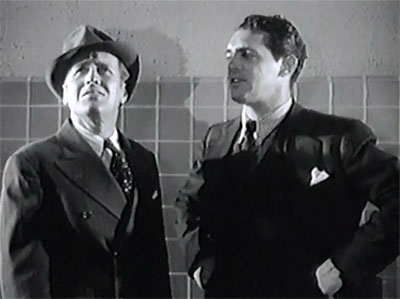
Above: Charles Quigley tries to convince George Chesebro of potential danger to the Channel Island Tunnel in Daredevils of the Red Circle (Republic, 1939).
Chesebro’s B-western schedule was so busy in 1940 that he made no serials at all that year. 1941, however, found him appearing in White Eagle, one of several Columbia chapterplays directed by James W. Horne. Horne, a former comedy director, tended to play his serials for laughs, and encouraged his actors to play their roles as humorously as possible. Chesebro, whose loudmouthed bad guys had always had a slight comic undertone to them, fit well into Horne’s oddball serial universe. However, Chesebro’s White Eagle character, a noisy outlaw named Blackie, was one of the less comical Horne-serial heavies portrayed by Chesebro–although only because Chesebro, whose character remained in the background in most of his scenes, had less time to engage in clownish activities in Eagle than in some of his subsequent Horne outings.
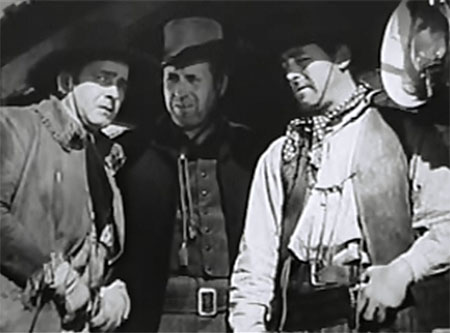
Above, left to right: An unidentified player, George Chesebro, and Kenne Duncan in White Eagle (Columbia, 1941).
The Horne-directed Columbia effort Holt of the Secret Service, released later in 1941, featured George prominently in the last five chapters as a thug named Rankin. One of the followers of a tropical-island crime boss (Stanley Blystone), Chesebro’s character seemed somewhat schizophrenic–happily bombing natives one moment, announcing to his boss that he was “sick of your murders” the next. In the final chapter, he brought in the authorities to clean up Blystone’s gang, but then reverted to villainy, murdering Blystone in an attempt to secure the serial’s “MacGuffin” (stolen Treasury plates) for himself. Chesebro couldn’t make sense of the character, but he seemed to enjoy making Rankin’s various outbursts as exaggeratedly emphatic as possible.

Above: George Chesebro corners Stanley Blystone in Holt of the Secret Service (Columbia, 1941).
Chesebro’s last Horne serial was Perils of the Royal Mounted (Columbia, 1942), which cast him as one of the leading henchmen, a swaggering and incompetent Canadian renegade named Gaspard. He and his fellow thugs played their part strictly for laughs, and, while quite amusing, seemed more like Keystone Kops than real menaces.

Above: George Chesebro and I. Stanford Jolley menace Nell O’Day in Perils of the Royal Mounted (Columbia, 1942).
Valley of Vanishing Men (Columbia, 1942), allowed Chesebro to return to his usual form as a slightly funny but still menacing badman—in this case, a bullying outlaw called Taggart, the principal henchman of ambitious Western criminal Kenneth MacDonald. Vanishing Men was the last serial in which Chesebro played the leading action heavy; he handled the role with zest, aggressively charging into action against hero Bill Elliott, reporting nervously to MacDonald after a setback, and confidently and gleefully berating inferior henchmen on their own failures.

Above: Roy Barcroft and George Chesebro in The Valley of Vanishing Men (Columbia, 1942).
Batman (Columbia, 1943), featured Chesebro as one Brennan, an agent of a Japanese spy ring; he bit the dust in an armored car crash in Chapter Five. The Phantom (also Columbia, 1943) kept George on screen much longer as Marsden, one of a gang of spies battling the titular jungle guardian (Tom Tyler). Though outranked by Sol Gorss on the henchman depth chart here, Chesebro frequently got to command the villains’ maneuvers, as the henchmen squads had a habit of splitting into separate groups at various points in the serial.
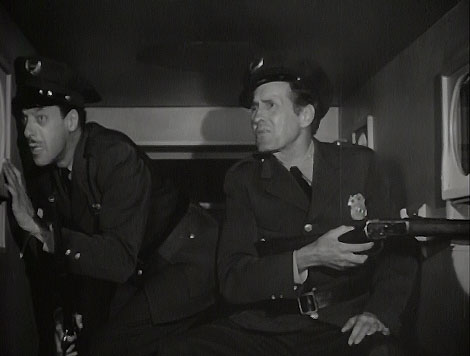
Above: I. Stanford Jolley and George Chesebro, disguised as armored-car guards, try to figure out where Batman (Columbia, 1943) has gone. (He’s on top of their armored car, but they won’t find out till it’s too late.)

Above, from left to right: Kenneth MacDonald, Guy Kingsford, Tom Tyler, Frank Shannon, and George Chesebro in The Phantom (Columbia, 1943). Ace the Wonder Dog is at Tyler’s feet.
After The Phantom, Chesebro played another henchman pack member in The Great Alaskan Mystery (Universal, 1944); though given very little dialogue, he enjoyed one vintage Chesebro moment when his character panicked at the prospect of facing inventor Ralph Morgan’s lethal “Peratron” ray and refused to carry out orders, despite threats from gang leader Anthony Warde.
Chesebro became almost exclusively a B-western player for the rest of the 1940s; he continued to appear in serials, but almost all of his remaining cliffhanger roles would be one or two-chapter bits. He had a walk-on as a fireman in Universal’s The Master Key (1945), played a villainous garage mechanic in Federal Operator 99 (Republic, 1945), and appeared briefly as a crook “auditioning” for villainous plastic surgery in Secret Agent X-9 (Universal, 1945). The Purple Monster Strikes (Republic, 1945) gave Chesebro only one extended scene, but allowed him to play a heroic character for a change–a chemical plant worker named Shaw who refused to divulge important information to thugs Bud Geary and Fred Graham, despite being brutally beaten. Hero Dennis Moore came to Chesebro’s rescue, but it was Chesebro who wound up saving Moore’s life when the hero was trapped in a chemical vat.
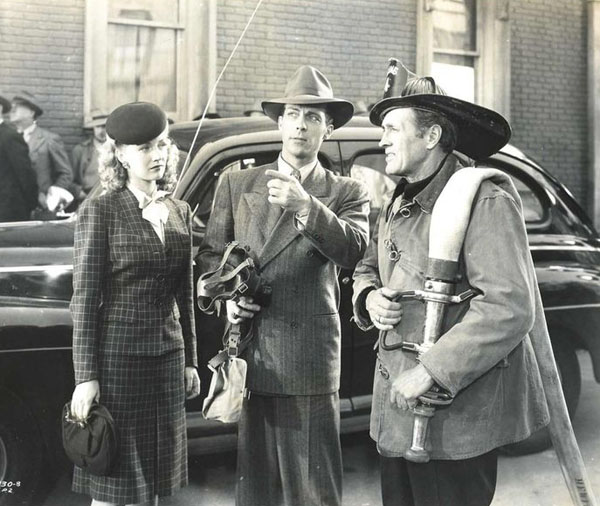
Above: Jan Wiley, Dennis Moore, and George Chesebro in The Master Key (Universal, 1945).

Above: Fred Graham works over George Chesebro while Bud Geary holds a gun on him in The Purple Monster Strikes (Republic, 1945).
The Phantom Rider (Republic, 1946), gave Chesebro a one-chapter bit as a murderous outlaw who gleefully announced his intent to send friendly Indian Chief Thundercloud “to the Happy Huntin’ Ground,” but then stopped a bullet from hero Robert Kent. Daughter of Don Q (Republic, 1946), featured Chesebro in a walk-on as a thug named Clay, who popped up just long enough to knock out heroine Adrian Booth and then assist in tying her up–all without uttering even a word of dialogue. His role in Son of Zorro (Republic, 1947) was only a little bigger, but at least gave him some lines; he played a gabby townsman who cheerfully and unthinkingly brought the heroine the news of the hero’s impending lynching. Jesse James Rides Again (also Republic, 1947), gave Chesebro a nice bit as a confident badman named Gus Simmons, who went to retrieve a valuable document from the supposed corpse of Jesse James (Clayton Moore) but was frightened into squealing when confronted by James’ “ghost.” The Black Widow, yet another 1947 Republic release, featured Chesebro in the first chapter as a non-villainous film developer.

Above: George Chesebro slowly turns to confront Clayton Moore’s “ghost” in Jesse James Rides Again (Republic, 1947).
Sandwiched in between these Republic bits was Chesebro’s last good-sized serial role, the part of Walt in The Vigilante (Columbia, 1947). Chesebro was uncredited, but his character–a henchman of crooked nightclub owner Lyle Talbot–was one of modern-day masked cowboy Ralph Byrd’s persistent opponents throughout the serial (although Chesebro was fifth man on the villains’ totem pole, behind Talbot, Jack Ingram, Eddie Parker, and Terry Frost). The serial’s rather offbeat mystery plot–which centered around five white horses whose shoes held the key to a hidden treasure–allowed Chesebro some amusing opportunities to express puzzlement and exasperation over being ordered to steal horses and remove and replace their shoes; he also got to engage in some of his trademark excitable panic when being questioned sharply by Byrd.
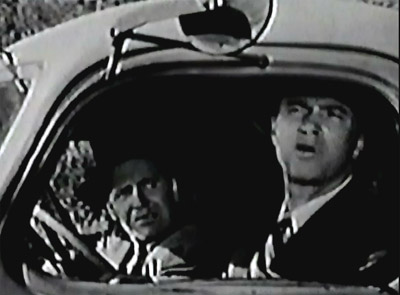
Above: George Chesebro and Eddie Parker in The Vigilante (Columbia, 1947).
Adventures of Frank and Jesse James (Republic, 1948), featured Chesebro in several chapters as a likably garrulous freight station agent, while Ghost of Zorro (Republic, 1949), cast him as an equally vociferous but much less likable lynch-mob leader in one sequence. Chesebro made his last cliffhanger appearance in Chapter Nine of Desperadoes of the West (Republic, 1950), as a frontier outlaw named Becker. His character was assigned to pose as a stage driver as part of a trap for hero Richard Powers; Chesebro rattled off a phony account of an outlaw attack with his usual flair before revealing himself, engaging in a chase and fight with Powers, and escaping on the coach’s detached team of horses.

Above: George Chesebro with Steve Darrell (center) and Clayton Moore in Adventures of Frank and Jesse James (Republic, 1948).
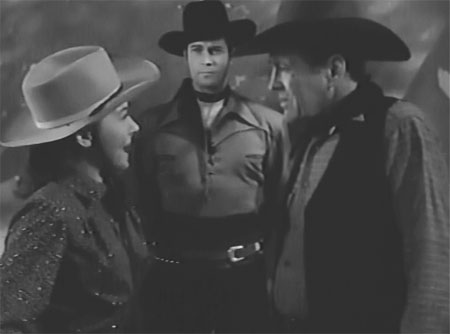
Above: Pamela Blake begs an unmoved George Chesebro not to shoot down the wrongfully-accused Clayton Moore in Ghost of Zorro (Republic, 1949).

Above: George Chesebro in Desperadoes of the West (Republic, 1950).
Chesebro, unlike many B-western and serial heavies, did no TV work in the 1950s, with the exception of a few appearances on The Lone Ranger. He kept working in B-westerns and occasional A-westerns, on an increasingly sporadic basis, until his retirement in 1954. He passed away in Los Angeles five years later.
George Chesebro became something of a legend to matinee fans while still working in films (as exemplified by his cameo as himself in the Roy Rogers film Trail of Robin Hood), and his fame among fans of cowboy films and cliffhangers has not diminished in subsequent decades. Credited or uncredited, in large parts or small, Chesebro made his many impetuous and irrepressible heavies impossible to overlook.
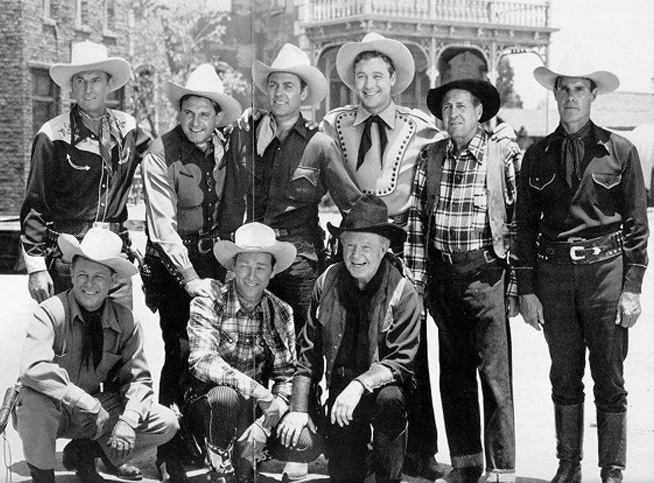
Above: A group publicity photo of the many Western celebrities who, playing themselves, aided Roy Rogers during the climactic scenes of Trail of Robin Hood (Republic, 1949). Kneeling left to right are Tom Keene, Rogers, and silent star William Farnum, while standing left to right are Tom Tyler, Ray Corrigan, Allan Lane, Monte Hale, our man George Chesebro, and Kermit Maynard. Chesebro’s usual “meanie” persona was commented on in the film itself, but he was nevertheless allowed to take his place among the heroes, in a wonderful tribute to his legendary status in B-westerns and serials. Photo courtesy of Jerry Schneider.
Acknowledgements: My thanks to the Western Clippings page on George Chesebro for biographical information, and to Jerry Schneider of the Movie Making Locations website for permission to use the above Trail of Robin Hood photo.
Nice job on your research into George Chesebro — I have a much better sense of his career now.
I’m amused looking at the “Trail of Robin Hood” lineup, which has something of “which of these is not like the rest” quality — a bunch of hero faces, and one well-worn face that cries out “henchman.”
In my research on the Iverson Movie Ranch, I find George comes up all the time — he was a regular at the ranch. I’m glad to learn more about him, and glad to see he’s getting some attention.
Keep up the good work. I’m enjoying your site.
George Chesebro always added something extra to the films he worked on…often using his deep, cynical voice. Andrew Sordoni
For anyone who hasn’t seen the film, his cameo in “Trail of Robin Hood” is priceless, and well worth searching out.